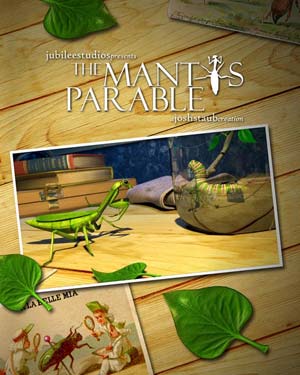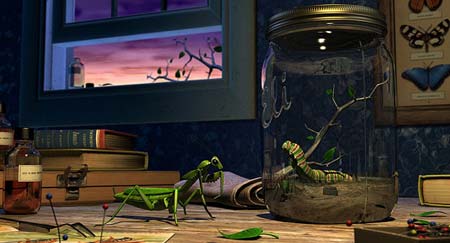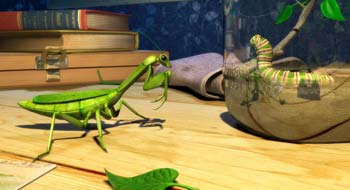

The Mantis Parable
Special thanks to Josh Staub for taking time out of his busy schedule to
talk about his work on the award winning animated short The Mantis Parable.
The Mantis Parable
// Josh Staub: 3D Animator
Tell us about yourself Josh; where are you from and how old were you when you discovered that you wanted to be an animator?
I'm originally from Boston Massachusetts, but was raised in the California Bay Area (Oakland), and currently reside just north of Spokane, Washington with my wife and two young children. As to how I got involved in art/animation, to be honest, I actually sort of stumbled into it. When I was about 13 I realized that I loved creating artwork on the computer (I had always loved to draw), but I really never thought I would end up doing it as a career. It wasn't until the opportunity presented itself when I was in my late teens that I saw it as an option for me.

As I mentioned, even as a little kid I loved to draw, but I did get into 3D very early. By the age of 15 I had saved up to buy my own computer (a Macintosh LC III - the cheapest Mac that would allow me to "render" 3D scenes using Stratavision 3D). I've tried to keep both my 3D and 2D skills sharp, and thankfully my job allows/requires that I spend time doing both.
Are you formally trained as an artist or are you self-taught?
I've never received any sort of formal artistic training. All of my traditional and CG skills are self-taught.
Do you think that artists with a formal education in animation or illustration have an advantage over self-taught artists?
I think for most people it is an advantage to have received formal artistic training, if for no other reason that you learn the basic foundational stuff, and you have the confidence in those fundamental skills. On the other hand, not having formal training might help an artist to avoid certain "fundamental ruts" that plague creativity...given the choice, I'd take the formal training route. Of course, the most important thing is to have a real passion for what you're doing - if you have that, nothing will stop someone without formal training from creating magnificent artwork with practice.
Who's work do you admire?
In terms of artwork, I'm actually most enamored with 2D artists right now - concept artists and matte painters in particular. Chris Mullins (goodbrush.com), Yannick Dusseault (dusso.com), Feng Zhu (artbyfeng.com), Ryan Church (ryanchurch.com), Erik Tiemens (watersketch.com), and Jose Manuel Oli (nibbledpencil.com) are some of my favorites. They're simply amazing! In terms of storytelling I'm a huge fan of Pixar, so obviously John Lasseter, Andrew Stanton, Brad Bird, and Pete Docter are huge inspirations for me.
You work for Cyan Worlds, Inc. Could you tell us how you got your start in the video game industry?
When I was 17 I got the opportunity to work for Cyan during the summer on a children's game called "Spelunx." Initially my job was to redraw the black-and-white images (that's how long ago it was), at which point I would send Robyn (co-founder of Cyan) the images and he would color them. For whatever reason I blew through the "re-drawing" phase, and with Robyn tied up with other projects he asked me to try coloring a few of the images. Two weeks later I had completed all but a few of the images for the entire project and Cyan gave me a job offer to skip college and come to work at Cyan full-time - believe it or not I turned them down! During the first few months of college I received other offers from Cyan, until finally they gave me an offer I couldn't refuse - to join the core team (there were 4 of us) responsible for designing and creating the sequel to Myst, which we ended up naming Riven.

I honestly believe that as long as you have a phenomenal portfolio, game companies don't care what art school you went to (or if you went to art school at all). Being a great artist and putting together that great portfolio - that's the tough part.
What steps should an aspiring Animator or Artist take to break into the video game business?
That's a tough question, because in reality, animators and artists as are two completely different jobs in the industry. Strictly speaking, animators focus primarily on gestures and movement, while artists (3D artists) will concentrate on modeling, texturing, lighting, etc. If you want to be an animator, I suggest you study great 2D and 3D animation (either at art school or on your own), beginning with the original Disney masters, all the way up to Pixar, Blue Sky Studios, and Dreamworks today. If you want to be a great 3D artist, you really need to study to be a great artist (period) first. Understanding composition, lighting, color, form, etc. is key to being any sort of artist, and I think a lot of 3D artists don't realize that. Most great traditional artists who have reasonable technical aptitude can easily transition into becoming great 3D artists. Unfortunately just knowing a 3D software package inside and out doesn't make one a great artist.
 You created your very own award winning animated short The Mantis Parable, Could you tell us about The Mantis Parable?
You created your very own award winning animated short The Mantis Parable, Could you tell us about The Mantis Parable?
The Mantis Parable is a film I created entirely on my own (story, visuals, animation, music, sound) during my spare time. Since its premiere roughly 12 months ago it has screened in over 40 film festivals around the world, won over a dozen top festival awards so far, and qualified twice for consideration for an Oscar nomination in the Best Animated Short film category.
Was The Mantis Parable your first animated short?
Yes. It's my first film.
When did you decide to create The Mantis Parable? What was your Inspiration?
Although I've been at Cyan for over 12 years now, I'm really not a gamer. I'm primarily interested in the storytelling and visual side of things. Storytelling in games, an essentially "non-linear" format, can be very frustrating, and there are a lot of visual limitations as well - particularly in the "real-time" games we've produced recently. A couple years ago it just seemed like the right time to venture into the world of film. I suppose making The Mantis Parable was like dipping my toe into the water to see what it feels like. Turns out, it feels great! I'm inspired by great storytelling that makes me think and feel, so creating a parable (which by definition is a short story that contains a moral message) seemed like an appropriate step for an animated short film.
Could you take us through your creative process when you started The Mantis Parable? How was the story mapped out before you actually started?
I started by writing the story, which - considering there's no dialogue in the film - ended up being more of an outline than a "script". From there I storyboarded the first act. Because storytelling in games is "non-linear", the act of storyboarding was a new experience for me, but was extremely helpful of course. After storyboarding the first act I spent some time designing the characters and environment, and when I was pretty comfortable with the concepts, I moved into production.
How long did it take to complete The Mantis Parable and what kept you motivated?
From start to finish the film took about 18 months to complete - which is a little misleading because most of those 18 months of production consisted of one or two nights a week. Staying motivated was a major challenge. When you're working on a long-term project entirely on your own in your spare time it can be very difficult to force yourself to work during those late nights when you're tired and you feel as though (a) you'll never finish the project, (b) even if you do finish it, no one will ever see it, and/or (c) you'd much rather be sleeping. Thankfully, it was during those times that I would invariably receive a friendly note from a fan eager to see the finished project, lifting my spirits, and helping me press on.
Did you complete The Mantis Parable alone or did you have help?
Everything in the film - story, visuals, animation, music, and sound - was done entirely by me alone. Taking my first step into film I really wanted to experience all the facets - the trials and tribulations - of making a film first-hand.
What were some of the challenges you faced during the making of The Mantis Parable?
There were so many challenges! Having never scored a film, recorded sound foley, or done much character animation, every phase of the filmmaking process was rife with challenges. Technically there was the constant struggle to get shots rendered using my home equipment requiring me to purchase additional RAM and external hard-drives to keep the project from stagnating. Keeping track of all the files, shots, and frames required for the film became a logistical nightmare as well.

Technically speaking, much of the physical creation of the assets - the modeling, texturing, lighting, composition, etc. was second-nature for me having worked with similar tools for many years. However, the biggest contribution from my experience in the game industry was time management and sheer stick-to-it-iveness. Stringent deadlines, too much work to do in too little time...these were concepts I was very familiar with so when things got complicated and overwhelming I was usually able to keep a cool head and manage the problems effectively.
The Mantis Parable has won many awards at film festivals and has even qualified twice for consideration for an Academy Award nomination in the Best Animation Short Film category. Did you ever think that The Mantis Parable would go so far?
To be perfectly honest, considering it was my first film I was just hoping it would be accepted to one festival so I could experience the joy of seeing the film on the big screen - I had no idea it would take off like it has.
How are you handling all the attention?
Ha! To be honest my daily life hasn't changed all that much. More than anything, I feel like I'm working two jobs - my day job at Cyan, and another one supporting the film. I spend several hours a week sending and preparing festival submissions and/or exhibition materials. I also try and attend at least a couple days of the major festivals I screen at, which means traveling once or twice a month. I'm bombarded by emails, mainly from people who have heard about the film and would like to see it. I also get a handful of unsolicited festival invitations per week, many of which I sadly have to turn down because of the overhead involved in exhibiting a film at a festival (every festival requires an exhibition screening copy of the film, press kit, promotional materials, etc.). It's a lot to manage for one person in their spare time!
Did the experience of making The Mantis Parable change you has an Artist?
At the very least, making The Mantis Parable has definitely broadened my horizons and increased my confidence. There were so many things that were new to me (scoring a film, sound design, character animation, linear storytelling), so to have worked so hard on those aspects of filmmaking and to have the short so well received has been very encouraging.
What's it like seeing something you created up on the big screen?
It really is an amazing feeling - one I'll never forget. The first few times I saw it on a movie screen I was very nervous, and extremely picky about things I should have fixed, etc. But I'm able to relax and enjoy it more now. To be honest, I'm really more interested in getting a sense of the audience's reaction to the film these days.
Can you tell us about your first experience having your film viewed at a film festival?
Amazing! The world premiere of The Mantis Parable was at the beautiful Egyptian Theater in Seattle, Washington as part of the Seattle International Film Festival, considered one of the top 10 film festivals in the United States, and the largest festival in the U.S. (over 180,000 attendees). My film screened as part of a children's program, which was great because it meant that my family (including my 2 young kids) could be there with me. Seeing and hearing the film in such a venue was exhilarating and I'll never forget it.
Is The Mantis Parable available on DVD? If not where can we see the film?
The Mantis Parable isn't available on DVD yet, but hopefully will be soon. Until then, the best thing to do is to frequent the "screenings" page at www.themantisparable.com and see if the film is coming to a festival near you. It's played in more than 40 festivals around the world so far, so stay tuned!
Have you considered starting your own animation studio or may be going to work for one of the big animation houses like Pixar or Dreamworks?
Yes. :) Starting my own studio would be incredibly fulfilling, but there's also a ton of overhead running a business that doesn't appeal to me at all, not to mention I really feel like I've got a lot to learn in the industry and there's something to be said for working in a collaborative environment with folks who've got a lot of experience already. On the other hand, working in a big studio (like DreamWorks or Pixar) would be a great learning experience, but you run the risk of getting "lost in the shuffle" because you're part of such a gigantic team. To be honest, I really haven't figured out what's next for me. Thankfully, I'm blessed to be in a position right now where I've received a lot of attention and support should I choose to go down one of these paths.
What advise would you give to the animator who reads this interview and wants to create there own Animated Short Film?
The best advice I can give is: Keep it simple, and don't stop working when things get tough. The road to a finished Animated Short Film is littered with animators who have crashed and burned attempting to create projects that are just too ambitious. Believe me, no matter how simple you think your film will be, in the end you will have plenty of challenges and difficulties to overcome, and when times get tough - just keep going. There were so many late nights when I was frustrated and just didn't feel like working on my film, but didn't give up, and neither should you!

I honestly believe the best way to start is to get a foundational knowledge of art and animation outside of the computer world first. It's so easy to pick up a copy of animation software and jump in without really knowing what you're doing. For me, the computer is just a vehicle, a tool, for processing what's in my head, and delivering it to an audience. If anything, I spend my time trying to make images/films that look like they have as little trace of the computer fingerprint on them as possible.
So what's next for Josh Staub, are you working on the sequel? What's the next big project?
Whatever I work on next, I won't be doing it on my own. It's too hard! I look forward to collaborating with others on the next project. There are no sequels planned for The Mantis Parable, but I do have a couple feature film ideas I'm beginning to develop. Stay tuned!
Any closing words of wisdom to all the animators and aspiring animators out there?
Work hard, keep learning, and don't give up!
Thanks again for this wonderful opportunity to share my experiences with the Animation Arena audience. I also encourage anyone interested to peruse The Mantis Parable website (www.themantisparable.com) which contains over two year's worth of information regarding the production of the film. For additional questions I can be reached at josh@themantisparable.com.
Thanks! :)




